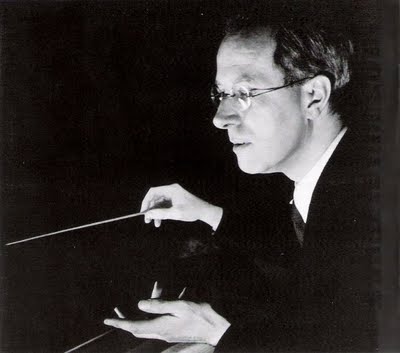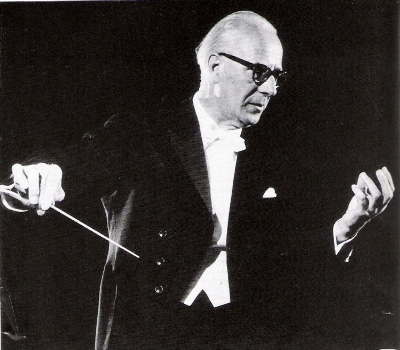<Back to Index>
- Conductor and Composer Otto Klemperer, 1885
- Conductor Eugen Jochum, 1902
PAGE SPONSOR
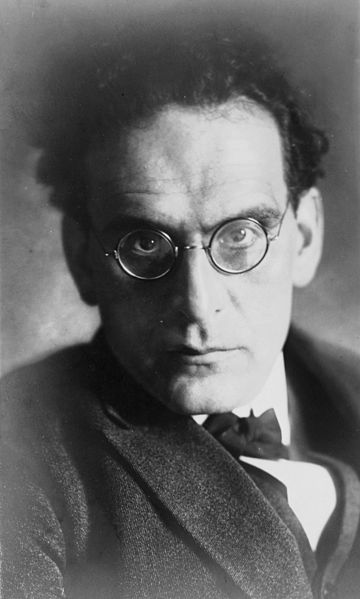
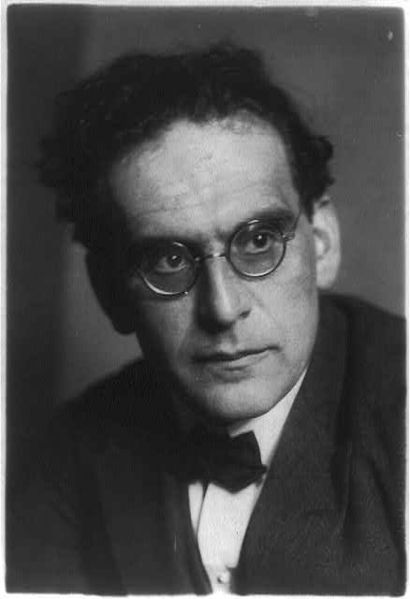
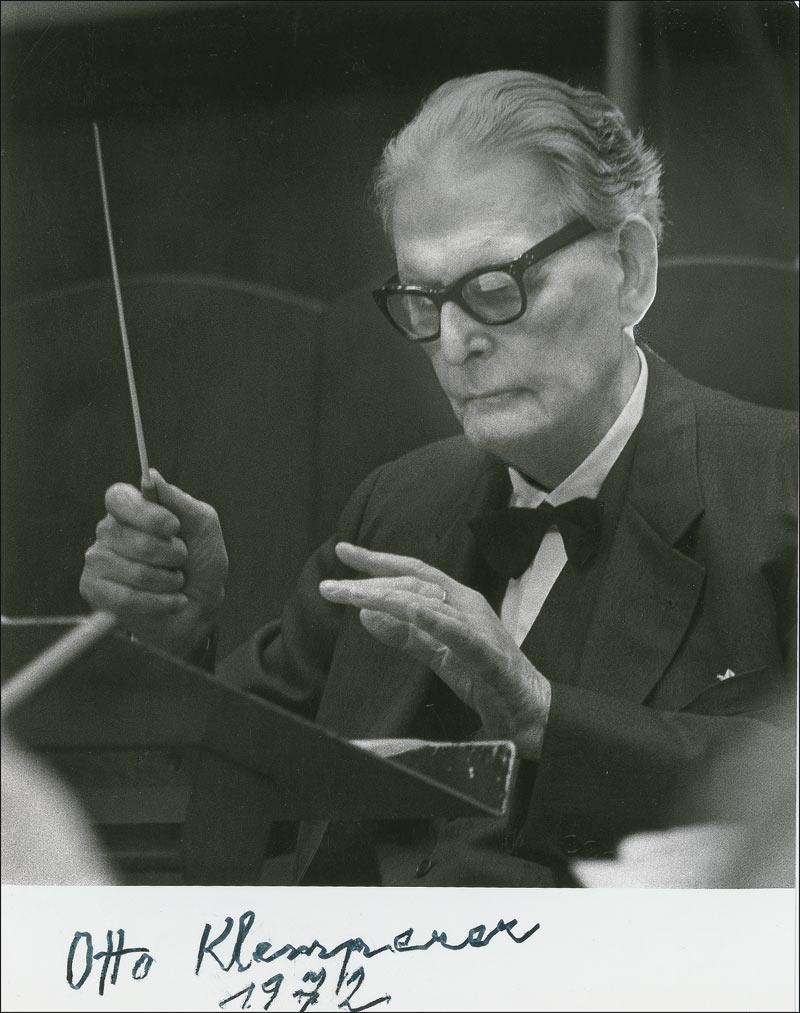
Otto Klemperer (14 May 1885 – 6 July 1973) was a German conductor and composer. He is widely regarded as one of the leading conductors of the 20th century.
Otto Klemperer was born in Breslau, Silesia Province, then in Germany (now Wrocław, Poland). Klemperer studied music first at the Hoch Conservatory in Frankfurt, and later at the Stern Conservatory in Berlin under James Kwast and Hans Pfitzner. He followed Kwast to three institutions and credited him with the whole basis of his musical development. In 1905 he met Gustav Mahler while conducting the off - stage brass at a performance of Mahler's Symphony No. 2, 'Resurrection'. He also made a piano reduction of the second symphony. The two men became friends, and Klemperer became conductor at the German Opera in Prague in 1907 on Mahler's recommendation. Mahler wrote a short testimonial, recommending Klemperer, on a small card which Klemperer kept for the rest of his life. Later, in 1910, Klemperer assisted Mahler in the premiere of his Symphony No. 8, Symphony of a Thousand.
Klemperer went on to hold a number of positions, in Hamburg (1910 – 1912); in Barmen (1912 – 1913); the Strasbourg Opera (1914 – 1917); the Cologne Opera (1917 – 1924); and the Wiesbaden Opera House (1924 – 1927). From 1927 to 1931, he was conductor at the Kroll Opera in Berlin. In this post he enhanced his reputation as a champion of new music, playing a number of new works, including Leoš Janáček's From the House of the Dead, Arnold Schönberg's Erwartung, Igor Stravinsky's Oedipus rex, and Paul Hindemith's Cardillac.
In 1933, once the Nazi Party had reached power, Klemperer, who was Jewish, left Germany and moved to the United States. Klemperer had previously converted to Catholicism, but returned to Judaism at the end of his life. In the U.S. he was appointed Music Director of the Los Angeles Philharmonic. He took United States citizenship in 1937. In Los Angeles, he began to concentrate more on the standard works of the Germanic repertoire that would later bring him greatest acclaim, particularly the works of Beethoven, Brahms and Mahler, though he gave the Los Angeles premieres of some of fellow Los Angeles resident Arnold Schoenberg's works with the Philharmonic. He also visited other countries, including England and Australia. While the orchestra responded well to his leadership, Klemperer had a difficult time adjusting to Southern California, a situation exacerbated by repeated manic - depressive episodes, reportedly as a result of severe cyclothymic bipolar disorder.
Then, after completing the 1939 Los Angeles Philharmonic summer season at the Hollywood Bowl,
Klemperer was visiting Boston and was diagnosed with a brain tumor; the
subsequent brain surgery to remove "a tumor the size of a small
orange" left him partially paralyzed. He went into a depressive state
and was placed in institution; when he escaped, The New York Times ran a cover story declaring him missing, and after being found in New Jersey, a picture of him behind bars was printed in the Herald Tribune. Though he would occasionally conduct the Philharmonic after that, he lost the post of Music Director.
Furthermore, his erratic behavior during manic episodes made him an
undesirable guest to US orchestras, and the late flowering of his career
centered in other countries.
Following the end of World War II, Klemperer returned to Continental Europe to work at the Budapest Opera (1947 – 1950). Finding Communist rule in Hungary increasingly irksome, he became an itinerant conductor, guest conducting the Royal Danish Orchestra, Montreal Symphony Orchestra, Cologne Radio Symphony Orchestra, Concertgebouw Orchestra, and the Philharmonia of London. His career was turned around in 1954 by the London based producer Walter Legge, who recorded Klemperer in Beethoven, Brahms and much else with his hand - picked orchestra, the Philharmonia, for the EMI label. He became the first principal conductor of the Philharmonia in 1959. He settled in Switzerland. Klemperer also worked at the Royal Opera House Covent Garden, sometimes stage directing as well as conducting, as in a 1963 production of Richard Wagner's Lohengrin. He also conducted Mozart's The Magic Flute there in 1963.
A severe fall during a visit to Montreal forced Klemperer subsequently to conduct seated in a chair. A severe burning accident further paralyzed him, which resulted from his smoking in bed and trying to douse the flames with the contents of a bottle of spirits of camphor nearby. Through Klemperer's problems with his health, the tireless and unwavering support and assistance of Klemperer's daughter Lotte was crucial to his success.
One of his last concert tours was to Jerusalem. Klemperer had performed in Palestine before the state of Israel declared its independence, and returned to Jerusalem only in 1970 to conduct the Israeli Broadcasting Authority Symphonic Orchestra in two concerts, performing the six Brandenburg Concerti and Mozart's symphonies 39, 40 and 41. During this tour he took Israeli citizenship. He retired from conducting in 1971. Klemperer died in Zurich, Switzerland, in 1973, aged 88, and was buried in Zurich's Israelitischer Friedhof - Oberer Friesenberg.
He was an Honorary Member (HonRAM) of the Royal Academy of Music.
His son, Werner Klemperer, was an actor and became known for his portrayal of Colonel Klink on the US television show Hogan's Heroes. The diarist Victor Klemperer was a cousin; so were Georg Klemperer and Felix Klemperer, who were famous physicians.
Klemperer is less well known as a composer, but he wrote a number of
pieces, including six symphonies, a Mass, nine string quartets, many
lieder and the opera Das Ziel.
He seldom performed any of these himself and they have generally fallen
into neglect since his death, although his works have received the
occasional commercial recording.
Many listeners associate Klemperer with slow tempos, but recorded evidence now available on compact disc shows that in earlier years his tempi could be quite a bit faster; the late recordings give a misleading impression. For example, one of Klemperer's most noted performances was of Beethoven's Symphony No. 3, the Eroica. Eric Grunin's Eroica Project contains tempo data on 363 recordings of the work from 1924 – 2007, and includes 10 by Klemperer - some recorded in the studio, most from broadcasts of live concerts. The earliest Klemperer performance on tape was recorded in concert in Köln in 1954 (when he was 69 years old); the last was in London with the New Philharmonia Orchestra in 1970 (when he was 85). The passing years show a clear trend with respect to tempo: as Klemperer aged, he took slower tempi. In 1954, his first movement lasts 15:18 from beginning to end; in 1970 it lasts 18:41. In 1954 the main tempo of the first movement was about 135 beats per minute, in 1970 it had slowed to about 110 beats per minute. In 1954, the Eroica second movement, "Funeral March", had a timing of 14:35; in 1970, it had slowed to 18:51. Similar slowings took place in the other movements. Around 1954, Herbert von Karajan flew especially to hear Klemperer conduct a performance of the Eroica, and later he said to him: "I have come only to thank you, and say that I hope I shall live to conduct the Funeral March as well as you have done".
Similar, if less extreme, reductions in tempi can be noted in many other works for which Klemperer left multiple recordings, at least in recordings from when he was in his late 70s and his 80s. For example:
(a) the Symphony No. 38 ("Prague") of Mozart, another Klemperer specialty. In his concert recording from December 1950 (when he was 65 years old) with the RIAS Berlin Orchestra the timings are I. 9:45 (with repeat timing omitted; the performance actually does take the repeat); II. 7:45; and III. 5.24. In his studio March, 1962 recording of the same work with the Philharmonia (recorded when he was 77 years old), the timings are notably slower: I. 10:53 (no repeat was taken); II. 8.58; III. 6:01. Unlike the late Eroica, the 1962 Prague is not notably slow; rather, the 1950 recording is much faster than most recordings of the work, even by "historically informed" conductors.
(b) The Anton Bruckner Symphony no. 4 (Haas edition with emendations). A 1947 concert recording with Concertgebouw Orchestra has timings of I. 14:03; II. 12:58; III. 10:11; and IV. 17.48. The studio recording with the Philharmonia from 1963 has timings of I. 16:09; II; 14:00; III. 11.48; IV. 19:01. Again, the 1963 is not a notably slow performance, but the 1947 was quick. The March 1951 recording with the Vienna Symphony Orchestra was even quicker: I. 13:26; II. 11:56; III. 9:22; IV. 16:30.
(c) The Mahler Symphony No. 7, recorded by Angel Records."Thus, as you listen to this performance, it seems... to enclose you within its own world of evocative sound, a world that echoes... the world we may know, but remains a world transformed by imagination, remote and complete within itself."
Regardless of tempo, Klemperer's performances often maintain great
intensity. Eric Grunin, in a commentary on the "opinions" page of his Eroica Project, notes: "....The massiveness of the first movement of the Eroica
is real, but is not its main claim on our attention. That honor goes to
its astonishing story (structure), and what is to me most unique about
Klemperer is that his understanding of the structure remains unchanged
no matter what his tempo... "
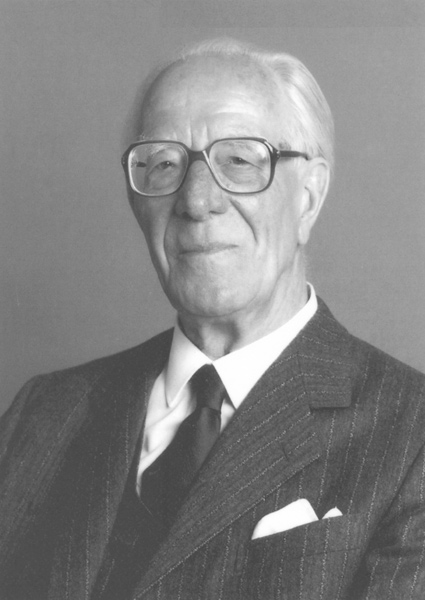
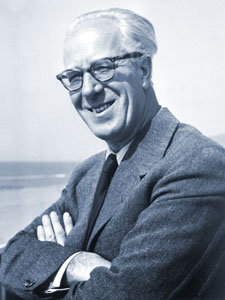
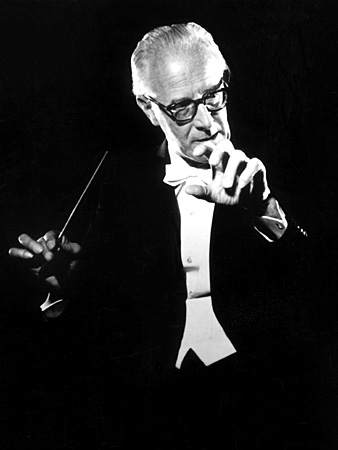
Eugen Jochum (1 November 1902 – 26 March 1987) was an eminent German conductor.
Born in Babenhausen, near Augsburg, Germany, Jochum studied the piano and organ in Augsburg until 1922. He then studied conducting in Munich. His first post was as a rehearsal pianist at Mönchen - Gladbach, and then in Kiel.
He made his conducting debut with the Munich Philharmonic Orchestra in 1926 in a program which included Bruckner's Seventh Symphony. In the same year he was appointed conductor at the Kiel Opera House, where he conducted seventeen operas in his first season, including The Flying Dutchman, Der Rosenkavalier and Turandot.
After Kiel he went to Mannheim, where Wilhelm Furtwängler praised his conducting. He turned down an offer to conduct twelve concerts with the New York Philharmonic Orchestra, believing that his repertory and experience were not yet equal to it. (He did not appear in America until 1958.) His next appointment was as music director in Duisburg, from 1930 to 1932. In 1932 he became chief of the Berlin Radio Orchestra, also conducting 16 concerts a season with the Berlin Philharmonic, and at the Deutsche Oper.
In 1934 Jochum succeeded Karl Böhm as musical director of the Hamburg State Opera and the Hamburg Philharmonic. Throughout the Nazi era, Hamburg remained, as Jochum put it, 'reasonably liberal', so that he was able to keep his post despite refusing to join the party. He performed music by composers such as Hindemith and Bartók elsewhere banned by the Nazis. He served at Hamburg until 1949. After World War II, Jochum became the first chief conductor of the Bavarian Radio Symphony Orchestra in 1949.
Jochum was also a regular guest conductor of the Concertgebouw Orchestra, Amsterdam, and served as the orchestra's 'first conductor' (eerste dirigent) from 1941 – 1943, during the chief conductorship of Willem Mengelberg. From 1961 to 1963, Jochum was joint chief conductor of the Concertgebouw Orchestra alongside Bernard Haitink. He conducted frequently in London, with the London Philharmonic Orchestra and the London Symphony Orchestra. In 1975, the LSO appointed him conductor laureate.
Jochum served as principal conductor of the Bamberg Symphony from 1969 - 1973. He later worked regularly with the Staatskapelle Dresden, with which he recorded the complete symphonies of Bruckner and "London" symphonies of Joseph Haydn.
He appeared regularly at the Salzburg Festival and, from 1953, Bayreuth Festspielhaus, where he made his debut conducting Tristan und Isolde.
Jochum is especially acclaimed for his two complete recordings of the symphonies of Anton Bruckner. He also made two complete recordings of the symphonies of Johannes Brahms, on the strengths of which the conductor Kenneth Woods called him "the greatest Brahms conductor who ever lived", and three complete cycles of the symphonies of Beethoven. His recordings of Bach, Mozart, Haydn, Schumann, Wagner and Carl Orff have also been highly praised. His 1967 recording of Carmina Burana is considered by Bill Alford to be an authoritative interpretation, as Orff himself was present at the recording and endorsed the final record.
He was a regular recording artist, from his first records in 1932 (the Mozart D minor piano concerto with Edwin Fischer). In the stereo LP era he recorded mainly for Deutsche Grammophon. His DG Bruckner cycle has remained in the catalogs ever since its first issue in the 1960s.
Regarding his podium technique, Kenneth Woods blogs, "Look at his hands - very small and focused motions but so powerful." Woods also states that "his sense of rubato, while still incredibly daring, is perhaps more unerring than [that of] even Wilhelm Furtwängler."
Jochum's younger brother Georg Ludwig Jochum was also a conductor. His daughter Veronica Jochum is a pianist on the faculty of the New England Conservatory of Music in Boston, Massachusetts, USA.
Jochum died in Munich, Germany, at the age of 84. His wife Maria predeceased him, in 1985.
